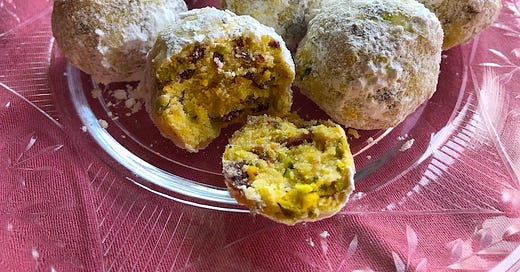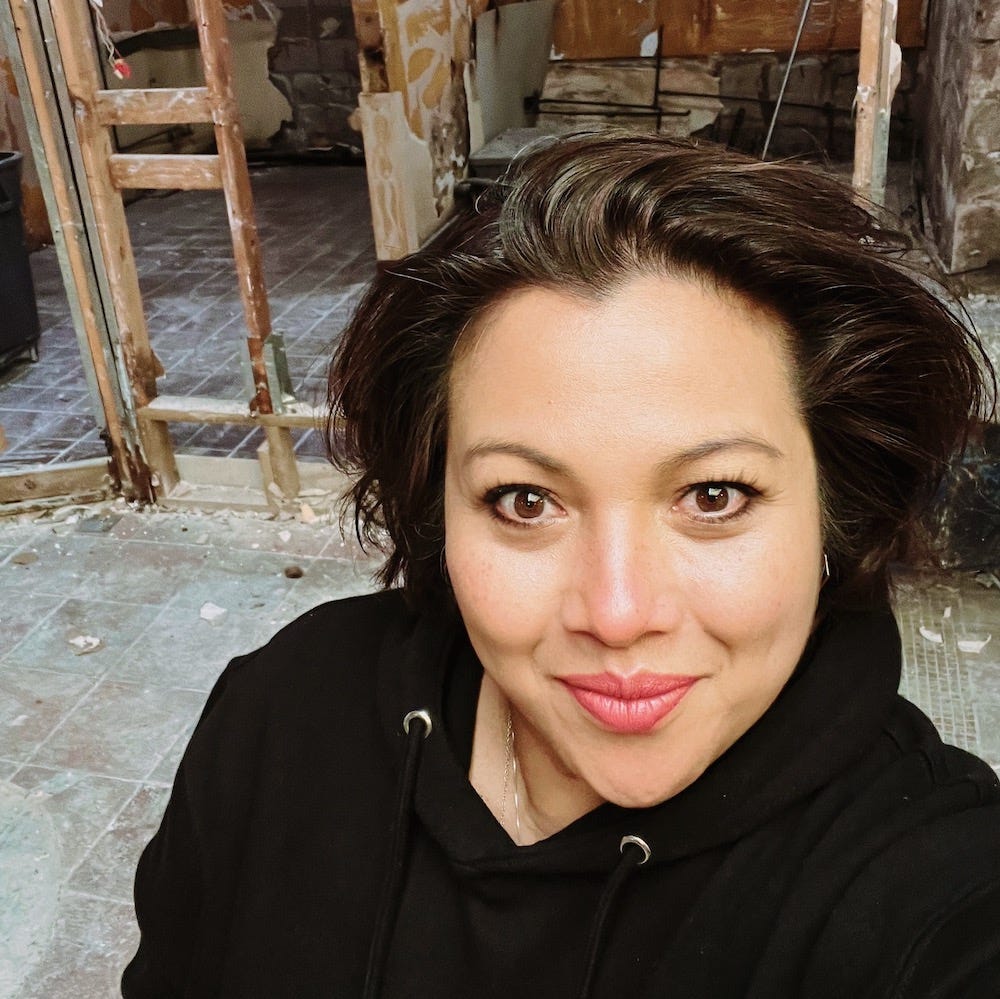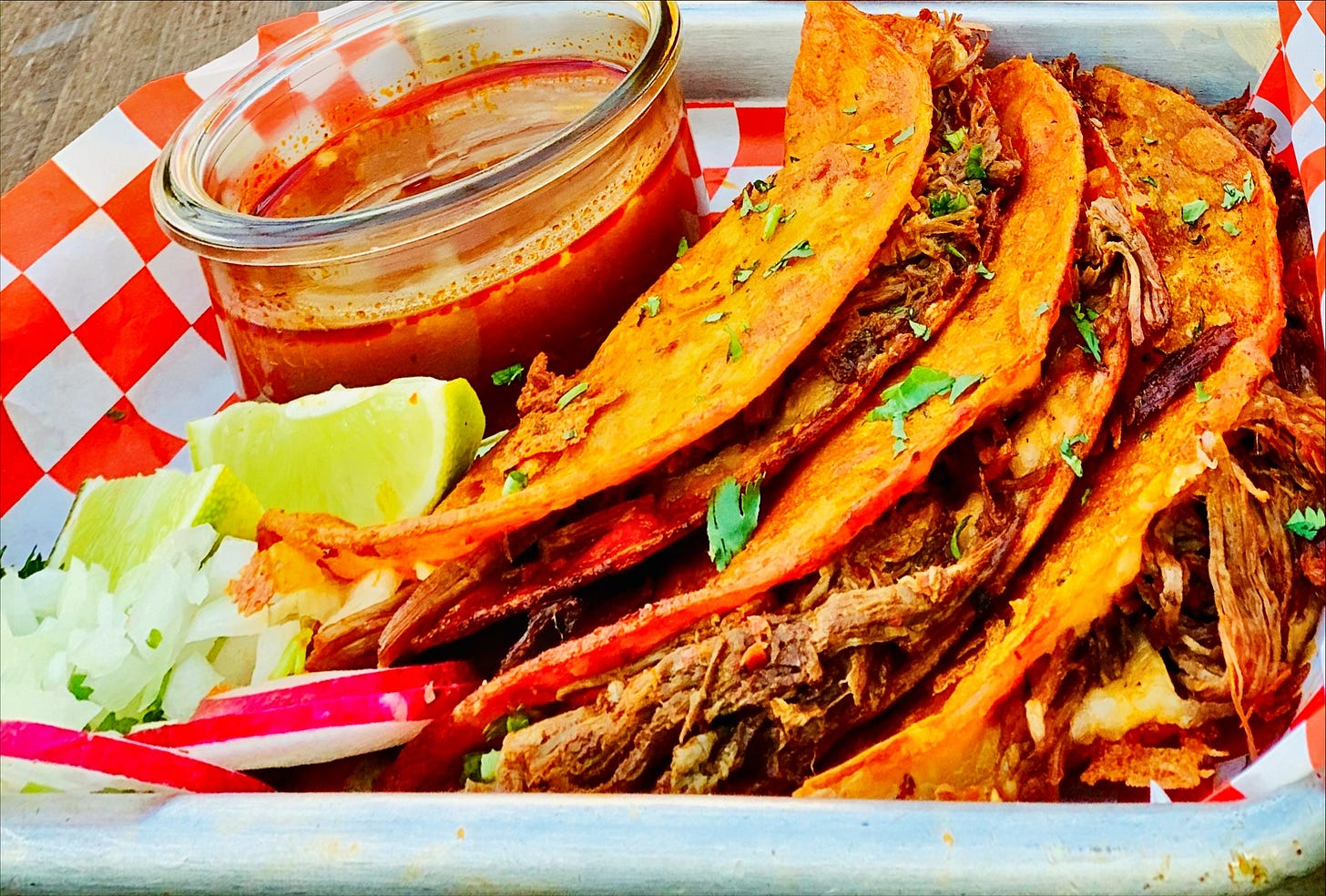I’m sending this week’s issue out a day early, because it includes an absolutely fantastic recipe for an Indonesian-South Asian take on Mexican wedding cookies, and I wanted you all to have time to make them before Christmas!
This week, I’m sharing a couple of conversations I’ve had with chef Nora Haron, whose pop-up, IndoMex—where she made phenomenal dishes like beef rendang quesabirria, Mexican rice congee, and laksa albondigas—was one of the real silver linings of 2020 and 2021. Over the course of a few months, Nora told me about how her relationship with her incredibly supportive partner inspired IndoMex and what the future holds. (Spoiler: There’s more than one restaurant in the works!)
Here are our conversations, condensed and edited for clarity:
Nora Haron
So, I came to this country about 21 years ago, with my then husband. I was born and raised in Singapore, and I am of Indonesian and Indian descent.
My mother owned a catering company. I had helped her throughout my young life. She is a single mother, so she raised my brother and I through help from family and through her catering. And I saw how strong she was, her determination and resilience. But she told me, “Oh, you're not going to become a cook, because look at how hard you have to work. Go be an engineer, or like your uncle; be something in science or something like that.”
I love fashion. I'm like the different one in the family. Not so studious. I became a shoe designer, and I worked in Italy, in Florence, and also in Luca. I learned to cook from the Italian women who were making our shoes. I would go to their homes, and, you know, learn how to cook. And the owner of our factory, his mom was a really fantastic cook, so I would sit with her and learn. And I decided, This is what I want to do.
The economy at that time was bad for fashion. It was so hard. We were designing for big names, but we were doing really badly, and it was such a cutthroat business, very competitive. But I think what really turned me off was having to use all these exotic animal skins. I couldn't do it anymore. And I had the burning desire to go back and do cooking.
I thought, You know what, I know how to cook from my mother; I want to learn how to bake and so I can be a well-rounded chef. So I went to San Francisco Baking Institute and did my pastry course there.
I landed my first job at Crema, in Oakland, and then they expanded to Berkeley. Then I joined Monkey Forest Road. I don't know if you remember them. It was an Indonesian themed restaurant—a gallery with a small cafe. I became their executive chef. I was really excited about cooking food that resembled home.
Eventually they sold. I did year as a catering as Director of Food Ops for Farley's and built a catering program. And then there was a job opening at Blue Bottle for a chef, and I was like, Oh my God, I love Blue Bottle; I want to work for them as a chef.
My title was Head Kitchen Manager for Blue Bottle, and I oversaw ops for our commissaries in New York, Oakland, LA, and Japan. I learned to do a lot of pastries, obviously, and also distribution in large quantities without tampering with the integrity of the food. And when we worked with Tartine, I got a chance to work with Chad and Liz Pruitt for a good six months or so, until Blue Bottle and Tartine split up.
Then I was approached by the architects that built Monkey Forest Road, from years ago, and they said, “We want to open a restaurant, Drip Line, in West Oakland. Will you be the chef there?”
Drip Line, I think, was my claim to fame. People were lining up—lines and lines out the door—and we were doing so, so well the first year. And then the second year, it kind of tapered down and we only did really, really well Friday, Saturday, Sunday—and that that wasn't sustainable for us. The rest of the week was quiet. They decided to call it quits because of the lack of business during the week.
I decided to join 4Ps restaurant group in San Francisco. I am still a partner. We have five locations.
So, what happened during the pandemic? In March, one day I came in, and it was just radio silence. We were right there on Rincon Hill, so it's tech industry. The tech people decided to work from home like two, three weeks before the official shutdown. So I came in, and my dining room was empty. All my reservations were canceled. All my banquet orders were canceled. One by one, everything was canceled.
We decided to close all the restaurants and just opened a local kitchen for takeout. And then what happened? I got depressed. We laid off 120 people. And it was so depressing to lay off folks, you know?
I realized a lot of my followers are from the East Bay. They would travel to San Francisco to see me, but San Francisco's numbers were so bad at that time, nobody wanted to go eat there. So I just said, “You know what? Let's do a pop up here, in Oakland. They can still eat our food, and we won't lose this momentum.”
I decided, Okay, let's do simple; let's do chicken rice. The first pop up, I just did one dish, and I did 150 orders in one day. It was amazing. I had no way for people to order—everybody was just texting me. So I said, Okay, I need to do a website or something. This is ridiculous! It grew from chicken rice, and I started adding a few more things.
I was worried, because I gave up my paycheck up way back February, when things were starting to slow down, so this was my only income. But my other half—Diego; my person I love so much—reminded me of something.
We had gone on vacation in November [of 2019] for Thanksgiving. We went to Indonesia, where we visited my family, and I had a freak accident: I fell in a six feet hole.
I was trying to catch a seashell he was throwing to me, and this drain cover gave way and I fell deep inside. He rushed up to get me, but by the time he got up the hill, I had already climbed out of that six-foot hole. I'm five-three, and I got out of a six-foot hole.
So he reminded me of that. He was like, “I saw you get out of a six foot hole before I could get to you. What is this pandemic?” And I said, “You know what? Enough said. You're right. F***k this depression. I'm going to go all out. Let's just do a full menu. Let's create a brand. I'm here in Oakland. I'm okay.”
Because he's of Mexican descent, I wanted to dedicate this menu to us—to having him supporting me and reminded me of my power, of what I can do. And so IndoMex was born.
When I first came to this country, I craved my mother's cooking. It was very hard to find Indonesian food. When I wanted Indonesian cooking, I had to go to the South Bay or San Francisco. Yes, there's Vietnamese food, there’s Thai food, but it's different, you know? I wanted my food. But the thing that I really enjoyed eating, that I thought was fresh and new to me, was Mexican food.
So I was already familiar with the beauty of Mexican cuisine and how similar some of the spices that they use are, and how they hit home to me. It’s not Southeast Asia, but it was comforting to me to know that there's something here that's familiar.
I would shop, I would go to the farmer's market and, I would make Mexican food at home. So when Diego came into my life, and when IndoMex was born, it was an easy marriage for me, because it was something I was already doing. It was like a no brainer. It wasn't like, Oh, what shall we infuse this with? It was something I had already been doing.
I used the word “Indo” not just for Indonesian but also for Indian, because I am also of Indian descent. So IndoMex was like a perfect word for this cuisine, this Indonesian-Indian-Mexican food.
My home kitchen is my test kitchen. What I cook for dinner for the children, and for us, ends up on the menu for IndoMex. So, we eat something at home, and we’re like, “Oh, this actually works. These flavors work.”
The first thing I ever did that represented both our cultures was a concha that had the flavors of Indonesia. I did flavors of coconut, turmeric, and makrut lime leaf. And it was so delicious. I was like, “This is our food! This is us, Baby!”
It’s all because he reminded me of that fall. I still have a scar from it. I look at it every day, and I'm like, “Oh shit—this pandemic? This is nothing.”
I’ve been so fortunate that through my work for IndoMex, I was discovered by Amanda Steckler, the owner of Singapore Kopitiam, Inc., who owns Killiney Kopitiam in Palo Alto.
Early this year, Amanda had a vision of an Indonesian restaurant and was looking for a local chef. I learned that I was chosen for the job in April. We’ve had some delays in the build out of the new restaurant, SanDai, which will be in Walnut Creek, and we weren’t able to open in 2021. However, I was also hired on to be the Director of Culinary for Killiney Kopitiam, in Palo Alto.
SanDai—meaning Three Generations—is set to open in the Spring of 2022 with an Indonesian Californian menu. I am very grateful of my journey. And I cannot wait to share this food with everyone.
Recipe: IndoMex Wedding Cookies
These cookies are a marriage of sugee cookies and polvorones/Mexican wedding cookies. They have the familiar crumbly, sweet texture of the cookies we often find in California around Christmas, but they’re made with ghee and chopped nuts (plus dried cranberries), which give them a flavor profile more akin to South Asian sweets. Nora notes that you need to use fine semolina in this recipe, to keep the batter from being too dry and crumbly. But if all you can find is the regular stuff, you can add an egg to the mixture.
Nora’s recipe is, of course, nicely measured out in grams, but I’ve added volume measurements here too, for those without an appropriate scale.
Makes ~20 cookies
Total Cook Time: 30 - 35 minutes, plus another 15 for cooling
Active Cook Time: 15 minutes
Ingredients:
100 grams ghee (6 tablespoons)
100 grams superfine sugar (1/2 cup)
100 grams all-purpose flour (3/4 cup + 1 tablespoon, spooned in—not packed)
100 grams fine semolina flour (1/2 cup + scant 3 tablespoons)
1 teaspoon baking powder
1 pinch fine sea salt
50 grams finely chopped pistachios (5 tablespoons + 2 teaspoons)
10 grams finely chopped dried cranberries (5 tablespoons + 1 teaspoon)
200 grams confectioner’s sugar, for coating (scant 2 cups)
Heat your oven to 325. Line a baking pan with parchment paper.
In a medium mixing bowl, mix the ghee and sugar until they’re well combined. [I did this with a stand mixer.] Add the flour, baking powder, salt, pistachios, and cranberries, and mix everything together until it forms a soft dough. [If your dough is too dry, it might be crumbly but still hold together when pinched.]
Gently roll and press the dough into 1” balls, and place them on the baking pan, leaving 1” of room between them.
Bake the cookies for 13 - 18 minutes, until tiny cracks start to form on the top. Remove the cookies from the oven, and allow them to cool on the baking pan for 10 minutes. (They’ll be soft at first but will crisp up as they cool.) When they’re warm but not too hot to work with comfortably, roll them in the powdered sugar.
The cookies will keep for up to 2 weeks in an airtight container.
Photos: Georgia Freedman, Courtesy Nora Haron (4)









